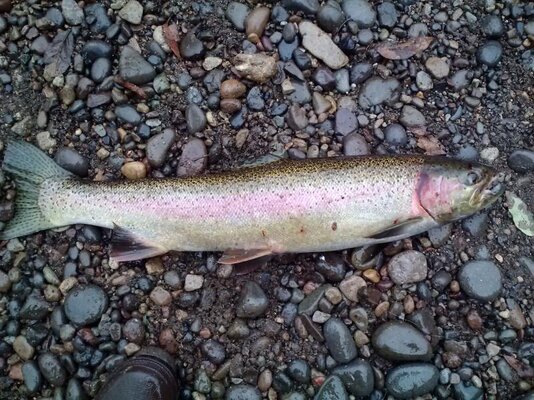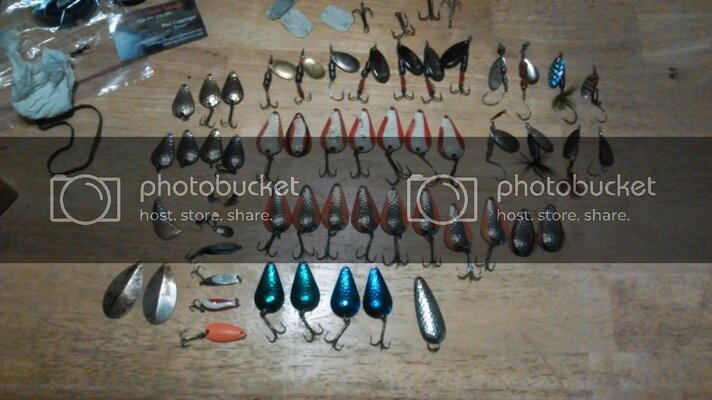M
meluvtrout
0
Can you guys share some info on how you fish tailouts for steelhead in small streams? Below is an article from salmon steelhead journal, and I'm looking for other or similar tactics to learn more about fishing the tailouts...
Tailout Tactics
By Dave Schamp
Having the opportunity to fish British Columbia's famous Skeena River for steelhead was a dreamcome true. I had heard many stories about its big powerful steelhead and couldn't wait to employ a little Yankee know-how on one of these brutes.Whilemy fishing partners were gearing up with heavy duty fly gear, I opted formy favorite drift rod andmade quick tracks to the river's edge.
The Skeena is a good-sized river and in the sectionwewere fishing it moves along at a surprisingly quick pace.Wewere fishing froma point on the river that serves as a natural funnel and the fishiest section was obvious. At the top of the funnel, just before it narrowed and dropped over into the fasterwater,was the place to be.
While my feather flipping friends enjoyed some pretty spectacular fishing throughout the day,my chosenmethod resulted in nothing but snagged Pink salmon and frustration. Before noon I had my fill of the Skeena and started looking forward to the next day when we were scheduled to head for Prince Rupert to troll for coho. That night the weather took a turn for the worse requiring cancellation of our planned trip to the salt, so we decided to return to the Skeena. Needless to saymy initial reaction was less than enthusiastic.
During breakfast a light came on inmy head. Knowing we would head back to the same area as the previous day, I decided to trymy favorite tailout sweeping technique. I repositionedmyself above the fishiest area, added a littlemore weight, and cast slightly downstream. This resulted in fewer snags and amuch better presentation, actually quite similar to whatmy buddies had been doing the entire previous day with their sinking tip fly lines.
The changed approach allowed my Spin-N-Glo to sweep across and through the top of the funnel instead of running parallel to the river's current as it had the day before. The result? Third cast, fish on! The action continued all day and it got to the point where the fly gear was abandoned and we were trading the drift rod back and forth. As soon as one of us hooked a fish, the other got a chance. In fact, the fishing was so good we argued about whether we shouldmiss dinner or just keep fishing.
[IMG2=JSON]{"data-align":"none","data-size":"full","src":"http:\/\/www.salmonandsteelheadjournal.com\/Portals\/0\/images\/fishing_tailouts_550.jpg"}[/IMG2]
This story illustrates several important steelhead lessons. First, if you've traveled a thousandmiles to fish one of the best steelhead rivers in the world don't let frustration ruin your trip. Second, if you know fish are present and you can't get themto bite, try a different approach. And finally, different sections of the river require a change in tactics to catch fish and tailouts are an excellent example.
In theWinter 2006 issue of Salmon & Steelhead Journal (page 22) I provided a simplified breakdown of the three sections of a steelhead run: the head, body and tailout. The ever popular standard drift fishing technique that employs a quarter cast up stream and results in your offering making initial bottom contact directly in front of you works very well when targeting fishing located in the body of the hole. It's not however, the best approach when targeting fish in a tailout.
Tail-outs are a unique challenge because the depth is changing fromdeep to shallow (the sharpness of this transition can vary greatly) and usually the water speed increases as the depth decreases. They can be wide and shallow or narrow and deep, and most runs have them, although at times they can be difficult to recognize such as the section described on the Skeena. Due to their unique characteristics adjustments in technique and changes in gear will help bring optimum results.
The primary goal is to cover all of the fish holding spots and this is best achieved by having your offering sweep, or swing, across the tailout. For bank anglers the easiest way to accomplish this is by selecting a casting position above the area to be fished, casting slightly downstream, and then lifting and retrieving line as the lure swings across.Make sure and let the lure swing clear to the bottomof the arc so that it is almost directly downstreamof the casting position. A lot of grabs happen just as the offering slows and they can be savage. As mentioned the key is sweeping the lure across the entire tailout area and adding a littlemore weight can sometimes help achieve the desired result.
Typical steelhead drift offerings can be used effectively in tailouts and casting plugs like aWiggleWart or Tadpolly are an option. A proven, but seldomused, technique is combining drift gear with a non-weighted spinner. Steelhead can't resist that spinning blade sweeping past their nose. Colorado blades, about the size of a nickel, on a short wire shaft with a couple of size 10 Corkies for the body can be killer. (Worden's Luresmake their famous Flash Glo spinners in a non-weighted version; sizes 123 and 124 are good, with their chrome blade and red bead combination beingmy favorite.) An even simpler approach is to use a plastic clevis to attach a spinner blade above a couple of Corkies right on your line. I use a 24- to 30-inch leader between the weight and spinner.
Another often forgotten favorite for sweeping tailouts are the FlatFish or Kwikfish style plugs. Relatively small ones, size F-5 to F-7 Flatfish and similar sized Kwikfish are about right. Productive colors include fluorescent red, fluorescent red/black dots and chrome/red dots. Rig these on a 36 to 40-inch leader between weight and plug. If they come equipped with a treble hook replacing it with a size 1 or 2 Siwash will reduce the possibility of hooks becoming tangled and improve hook ups. An excellent way to add a Siwash is to pry open the attachment eye on the plug and install a size 10 barrel swivel then crimp an open eye Siwash to the other end.
Tailouts are also an excellent place to use spoons (wobblers). For this application I recommend using designs with wide tear shaped bodies rather than themore common long narrow shapes. Because tailouts are usually fairly shallow, getting deep isn't the primary objective here.
Finally, some basic advice regarding landing a steelhead hooked in a tailout. Because they are often close to the safety of fast water, fish hooked in a tailout almost always head downstream. Sometimes it is very difficult to give chase so it's imperative to get the fish to come back upstreamand into the hole. The bestmethod I've found to do this is after a good hook-set, drop the rod tip to the water's level (or even in the water) and while keeping steady pressure and a good arch in the rod, slowly walk upstream. Very often the combination of steady pressure combined with a line of pull at or near its level will result in even the wildest steelhead slowlymoving back into the hole. No guarantee with this one, but it's worked many times for me through the years.
Last edited by a moderator:

